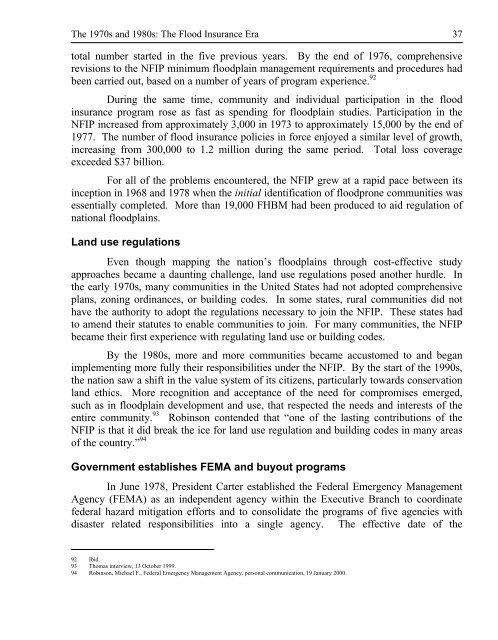The Nation's Responses To Flood Disasters: A Historical Account
The Nation's Responses To Flood Disasters: A Historical Account
The Nation's Responses To Flood Disasters: A Historical Account
Create successful ePaper yourself
Turn your PDF publications into a flip-book with our unique Google optimized e-Paper software.
<strong>The</strong> 1970s and 1980s: <strong>The</strong> <strong>Flood</strong> Insurance Era 37<br />
total number started in the five previous years. By the end of 1976, comprehensive<br />
revisions to the NFIP minimum floodplain management requirements and procedures had<br />
been carried out, based on a number of years of program experience. 92<br />
During the same time, community and individual participation in the flood<br />
insurance program rose as fast as spending for floodplain studies. Participation in the<br />
NFIP increased from approximately 3,000 in 1973 to approximately 15,000 by the end of<br />
1977. <strong>The</strong> number of flood insurance policies in force enjoyed a similar level of growth,<br />
increasing from 300,000 to 1.2 million during the same period. <strong>To</strong>tal loss coverage<br />
exceeded $37 billion.<br />
For all of the problems encountered, the NFIP grew at a rapid pace between its<br />
inception in 1968 and 1978 when the initial identification of floodprone communities was<br />
essentially completed. More than 19,000 FHBM had been produced to aid regulation of<br />
national floodplains.<br />
Land use regulations<br />
Even though mapping the nation’s floodplains through cost-effective study<br />
approaches became a daunting challenge, land use regulations posed another hurdle. In<br />
the early 1970s, many communities in the United States had not adopted comprehensive<br />
plans, zoning ordinances, or building codes. In some states, rural communities did not<br />
have the authority to adopt the regulations necessary to join the NFIP. <strong>The</strong>se states had<br />
to amend their statutes to enable communities to join. For many communities, the NFIP<br />
became their first experience with regulating land use or building codes.<br />
By the 1980s, more and more communities became accustomed to and began<br />
implementing more fully their responsibilities under the NFIP. By the start of the 1990s,<br />
the nation saw a shift in the value system of its citizens, particularly towards conservation<br />
land ethics. More recognition and acceptance of the need for compromises emerged,<br />
such as in floodplain development and use, that respected the needs and interests of the<br />
entire community. 93 Robinson contended that “one of the lasting contributions of the<br />
NFIP is that it did break the ice for land use regulation and building codes in many areas<br />
of the country.” 94<br />
Government establishes FEMA and buyout programs<br />
In June 1978, President Carter established the Federal Emergency Management<br />
Agency (FEMA) as an independent agency within the Executive Branch to coordinate<br />
federal hazard mitigation efforts and to consolidate the programs of five agencies with<br />
disaster related responsibilities into a single agency. <strong>The</strong> effective date of the<br />
92 Ibid.<br />
93 Thomas interview, 13 October 1999.<br />
94 Robinson, Michael F., Federal Emergency Management Agency, personal communication, 19 January 2000.
















